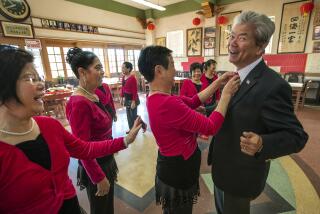Far East Moves to Old West Music
- Share via
SINGAPORE — Every Saturday night, Chen Kuo Wei is out on the town: belting out “God blessed Texas with his own hand” and dancing in his straight-cut blue jeans and knee-high cowboy boots.
Never mind that he’s never been to Texas, or even the United States. Chen, 55, a retired businessman with a long silver ponytail, loves to line dance.
So do thousands of other Singaporeans.
There is something about dancing to the music of the Old West that resonates in the Far East, especially in this tightly controlled tropical island where people are constantly hectored to keep in step.
Enthusiasts in the Southeast Asian city-state trace the phenomenon back to the late 1990s when a Japanese dance instructor introduced line dancing.
Some 12,000 Singaporeans even boogied their way into the Guinness Book of World Records in May 2002 by turning a dance floor the size of eight football fields into a giant hoe-down. But they were unseated months later by Hong Kong, the current record holder for the “world’s largest country line dance” with 12,168 dancers.
So what is it about tush-pushing that Singaporeans like so much?
“It’s a healthy sport and you don’t need a partner,” said Shirley Wee, 51, a retired secretary who has been dancing for almost seven years. “It also keeps you less senile because it involves a lot of brainwork to memorize the routines.”
Line dancers don’t grandstand or clamor for the limelight. Instead, it’s all about staying in sync -- which Singaporeans do virtually every day.
“When you dance in a crowd, you feel less shy,” Wee said.
Routine is everything in Singapore, critics say, and line dancing suits Singaporeans because it emphasizes conformity and reflects the city-state’s fear of risk-taking.
“I think there’s a certain security in having your movements prescribed to you, and it seems very Singaporean to be playing follow the leader,” said Yong Shu Chiang, a culture critic for Today newspaper.
On a recent Sunday night at Far East Square, a restaurant-lined courtyard in the financial district, dozens of dancers assembled in long, meticulous rows, and stepped with military precision and focus. Their perfectly timed stomps and claps punctuated the instructor’s commands: “Toe, heel, kick-ball-change!”
Country singer Johnny Horton’s voice blasted through the loudspeakers: “He does an Indian boogie to a white man’s song, singing ‘Hey-ho-a-lina.’ ”
“Hey-ho-a-lina!” The shimmying crowd chorused without missing a beat.
But there’s a hint of revolution in Singaporean line dancing -- some fans are experimenting with infusing their dancing with a more Asian flavor.
For example, Chen has created line dance routines to go with songs by Taiwanese pop sensation Jay Chou and Thai superstar singer “Bird” Thongchai McIntyre.
“I’m choreographing for Asian songs because I believe that line dance should evolve,” Chen said.
The embellishments grate on line-dancing purists, and many DJs at dance parties refuse to play Asian hits.
“These dances usually stay for a week or two and disappear thereafter. They have no staying power,” said Michael Pang, head of the Country Line Dance Assn. of Singapore, which has a membership of more than 500 dancers and instructors.
Pangs says his group is firmly in the camp that prefers “good old country music.”
“Imagine being dressed in country and western outfits and dancing to Chinese music?” he said.
Chen still sports the boots, but says the traditional outfit doesn’t make sense in Singapore’s balmy, equatorial climate.
He has traded his Stetson for a black bandanna and wears T-shirts instead of the long-sleeve cowboy shirts that Singapore’s purists prefer.
“It’s just too hot here,” Chen said. “I’ll be drenched in sweat if I’m wearing one of those checkered shirts.”
But the stylistic differences don’t seem to bring real friction among the boot-scooters.
“At the end of the day, it is just the joy of dancing that matters,” Chen said.
More to Read
Sign up for Essential California
The most important California stories and recommendations in your inbox every morning.
You may occasionally receive promotional content from the Los Angeles Times.










